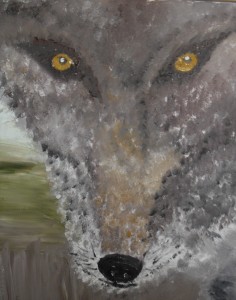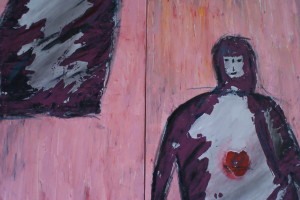Neeltje van Leeuwen
Born in 1962 in Dieren ( Gelderland, the Netherlands)
School of Arts Arnhem ( now ArtEZ ), Department of Fine Arts
1st grade teacher crafts , philosophy and art history
Activities: Spatial objects and installations in various materials , with a recognizable preference for ceramics . From 2009 has weaving take over the function of ceramics .
Paul Hoftijzer
Born in 1950 in Stein ( Limburg, the Netherlands )
Technical University Eindhoven, study Architecture
Professional School for gold and silversmiths , Schoonhoven
As a self-taught painter
Activities : paintings on wood and canvas (mainly oil ) larger sizes objects with a conscious (re – ) use of diverse materials
stage sets and lighting control / texts , stories , myths and poems .
Together installations occur both indoors and in the open air , blurring the boundaries of everyone’s contributions .
Existed around 1995 these plants mainly of series objects,
at fixed distances along a predetermined route on a map drawn were installed .
One of the longest routes ran from the Pyrenees ( French-Spanish border ) to the Achterhoek in the Netherlands , where exactly to fifty kilometers an object was placed . Objects themselves had the character of an archetype of a mother earth / Mary altar , with a strong iconographic character .
After 1997 installations were only placed outside .
The content of these plants was direct and often linked to deeper spiritual idea.
The installations are regularly captured through photographs. These photographs together with macro photography are often a part of the expositions f up to about 2000 .
The philosophical background of Paul & Neeltje , mainly based on eco – sophy and their quest for a common European spiritual tradition ( with influences include Christianity, Judaism , Shamanism and Druidism ) , have increasing influence in their work .
Neeltje ’s visual work often primal forces are given shape that forms the foundation of our existence . a quest for everybody’s own existence and origin .
This in the most simple manner with the simplest means.
In Paul ’s seemingly simple design his own imagery is often the binding factor in both his abstract and figurative work.
Paul & Neeltje never used Land Art as term for their artistic expressions.
However, many of their artworks can be seen as Land Art. Especially when it responds to certain features of the landscape and the landscape is manipulated, so we see it with different eyes. For their art-installation-trips they use the nature even as decor. The installations follow the rime of the nature and become in their own way integrated.
Neeltje & Paul make monumental installations with a very own recognizable character. In this work, both contributions are visible, but at the same time the contribution of the one fleets simple in other one else’s work on. Is a characteristic feature, moreover, that their installations are so designed that they are apparently in the time to adapt to the changes in the rhythm of nature.
Around 1995, their artwork mainly exists of series objects, realized at fixed distances along a pre-drawn on a map route. One of the longest routes ran from southern France to the Achterhoek ( the very east of the Netherlands), where exactly at every fifty kilometers an object was placed.
After 1997 installations are made only outwards. The content of these installations was more direct and often associated with a deeper spiritual idea. The installations are regularly recorded through pictures, these pictures were combined with macro photography till the end of 2000.
The artworks were often deliberately designed so that they slowly fell back and were included in the natural environment. The result that it’s become increasingly difficult to observe, what human intervention is and what isn’t. It is clear that what we in Western Europe (and especially in the Netherlands) call nature, always will be a product of human intervention. By making “art” installations with a ‘apparent’ natural decay, they try clearing some parts of that mystification..
From 2009 they created 6 series installations with wicks of wool at various special places: include at Wéris, the Externsteine, the dolmens at Visbeker Braut and near the Escargos in Burgundy.
They started several annually traveling art installation trips at a fixed distance along a predetermined route. Through photos and PowerPoint presentations, these trips are recorded.
On the estate Enghuizen at Hummelo and the Arboretum at Villa Ruimzicht in Doetinchem in 2012 two large installations are realized.
Also on Enghuizen estate in the context of the 14th art trail in the spring of 2013 a large installation was made “The Holy of Enghuizen”.
In 2013 they realized installations near castle ‘t Hackfort near Vorden and
in Maastricht as Dutch participants of International Landart Maastricht.






